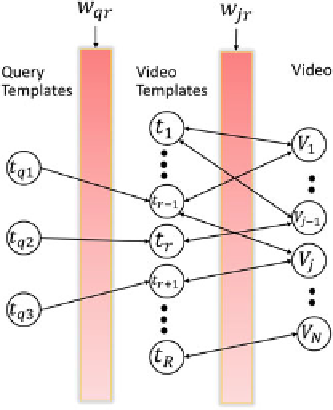Database Reference
In-Depth Information
Fig. 3.13
An architecture of
the adaptive cosine network
implementing the pseudo-RF
method for video retrieval
third layers, which allows the network to find templates that appear to be relevant
on the basis of the initial ranking, and use those templates to refine the ranking
process.
Figure
3.14
graphically describes the spreading activation process. Figure
3.14
a
shows two query templates sending signals to the video template nodes
{
a
,
b
}
.The
video nodes:
are activated (the application of thresholding is omitted to
simplify illustration). Figure
3.14
b shows the signals propagating backward to the
video template layers. At this time,
f
{
c
,
d
,
e
}
g
and
h
are the newly activated nodes. After
re-calculating the node activations, the video template nodes send signals forward to
the video nodes as shown in Fig.
3.14
c. This results in a new ranking, which includes
a new video node,
i
. We see that the network then utilizes video template node
f
,
present in the initial ranking, to find a higher number of relevant video nodes.
,
3.5.2.2
Network Adaptation and Learning
Let
v
q
=
{
denote the set of the query's weight components,
obtained by converting the video query
w
qr
|
r
∈
[
1
,...,
R
]
}
V
q
into a set of templates, and weighting
r
(
q
)
,
r
(
t
)
}
from the
r
-th query node to the
r
-th video template node. Also, let
mesg
r
(
t
)
ₒ
j
(
v
)
denote the message sent along the connection
vectors. Let
mesg
r
(
q
)
ₒ
r
(
t
)
denote the message sent along the connection
{
r
(
t
)
,
j
(
v
)
}
{
from the
r
-th video
template node to the
j
-th video node,
j
∈
[
1
,
N
]
. Note that
mesg
r
(
q
)
ₒ
r
(
t
)
is a
one-to-one correspondence, while
mesg
r
(
t
)
ₒ
j
(
v
)
is a one-to-many correspondence.

Search WWH ::

Custom Search